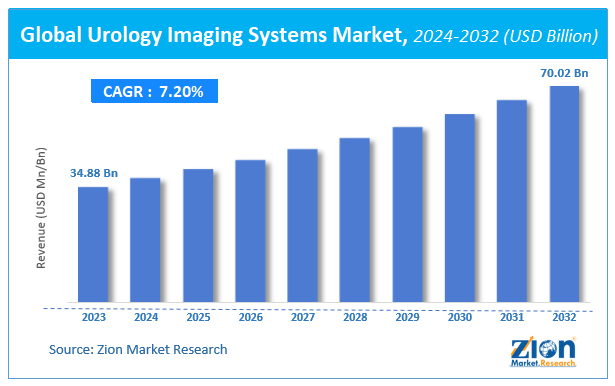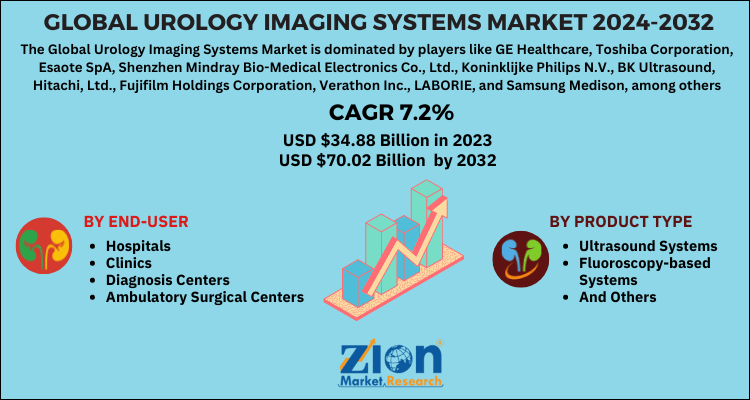Urology Imaging Systems Market Size, Share, Trends, Industry Analysis & Growth 2032

Urology Imaging Systems Market By product type (ultrasound systems, fluoroscopy-based systems, and others), By end-user (hospitals, clinics, diagnosis centers, and ambulatory surgical centers) And By Region: - Global And Regional Industry Overview, Market Intelligence, Comprehensive Analysis, Historical Data, And Forecasts, 2024-2032
| Market Size in 2023 | Market Forecast in 2032 | CAGR (in %) | Base Year |
|---|---|---|---|
| USD 34.88 Billion | USD 70.02 Billion | 7.2% | 2023 |
Description
Urology Imaging Systems Market Insights
According to the report published by Zion Market Research, the global Urology Imaging Systems Market size was valued at USD 34.88 Billion in 2023 and is predicted to reach USD 70.02 Billion by the end of 2032. The market is expected to grow with a CAGR of 7.2% during the forecast period. The report analyzes the global Urology Imaging Systems Market's growth drivers, restraints, and impact on demand during the forecast period. It will also help navigate and explore the arising opportunities in the Urology Imaging Systems industry.
Global Urology Imaging Systems Market: Overview
Urologic imaging system is an important part of the daily clinical practice in urology departments. Hospitals and specialty clinics are now adapting to the latest urology imaging devices that include ultrasound devices, X-rays, MRI, CT scan, etc. Diagnostic imaging technology in urology is transforming into an advanced system that not only identifies lesions but also helps to predict their clinical relevance. Healthcare professionals around the world prefer to use urology imaging systems for the treatment of urinary tract infections, as different urinary tract problems may show the same symptoms. Hence, with the help of urology imaging systems, healthcare professionals can pinpoint a problem accurately.
Global Urology Imaging Systems Market: Growth Factor
The global urology imaging systems market is expected to grow with substantial growth over the forecast period. The factors attributing to the growth of the market include increasing prevalence of urological diseases and raising awareness for the early diagnosis of chronic kidney diseases and related disorders. The demand for ultrasound devices in the urology sector is majorly influenced by increasing cases of prostate cancer, renal dysfunction, urolithiasis, etc. Urology health is important for better life, but cancers & diseases of prostate, bladder, kidney, and the male reproductive system are becoming more predominant and disturbing the lives of millions of men, women, and children globally. However, imaging systems are proven to be helpful in pinpoint diagnosis of diseases related to urology, this aid in better effective treatment to the patients.
On the other hand, the dearth of skilled and well-trained medical imaging devices operator may hamper the growth of the global urology imaging systems market. Technical skills and on-hand experience are very important to ensure the optimal use of imaging devices for accurate and effective disease diagnosis as poorly captured images may lead to inaccurate interpretation and the unnecessary repetition of examinations. However, technological advances in imaging systems will provide better growth opportunities to the global urology imaging systems market.
COVID-19 pandemic situations have adversely affected the growth of urology imaging systems market, strict lockdowns and restrictions on personal movements have adversely affected the manufacturing of urology imaging systems. Furthermore, restrictions imposed on material transport by several governments to control the spread the COVID-19 infections has disrupted the distribution network and supply chain. However, major players in the market have now resumed their operations and many restrictions on the import & export has been lift up by the majority of the governments which is expected to get back the market growth on its tract over the forecast period.
Global Urology Imaging Systems Market: Segmentation
The global urology imaging systems market is bifurcated based on product type, end-user, and region.
Based on the product type, the global urology imaging systems market is split into ultrasound systems, fluoroscopy-based systems, and others. Among these, the ultrasound systems are expected to dominate the market over the forecast period.
On the other side, the end-user segment in the global urology imaging systems market is divided by hospitals, clinics, diagnosis centers, and ambulatory surgical centers.
Urology Imaging Systems Market: Report Scope
| Report Attributes | Report Details |
|---|---|
| Report Name | Urology Imaging Systems Market |
| Market Size in 2023 | USD 34.88 Billion |
| Market Forecast in 2032 | USD 70.02 Billion |
| Growth Rate | CAGR of 7.2% |
| Number of Pages | 214 |
| Key Companies Covered | GE Healthcare, Toshiba Corporation, Esaote SpA, Shenzhen Mindray Bio-Medical Electronics Co., Ltd., Koninklijke Philips N.V., BK Ultrasound, Hitachi, Ltd., Fujifilm Holdings Corporation, Verathon Inc., LABORIE, and Samsung Medison, among others |
| Segments Covered | By Product Type, By End-User And By Region |
| Regions Covered | North America, Europe, Asia Pacific (APAC), Latin America, Middle East, and Africa (MEA) |
| Base Year | 2023 |
| Historical Year | 2018 to 2022 |
| Forecast Year | 2024 - 2032 |
| Customization Scope | Avail customized purchase options to meet your exact research needs. Request For Customization |
Global Urology Imaging Systems Market: Regional Analysis
Asia Pacific region is expected to register rapid growth in the global urology imaging systems market. The factors influencing the growth of the market in this region include increasing adoption of advanced medical technologies, significant growth in the cases of urinary tract infections, and increasing investments of major market players in this region. North America is expected to be the dominant market in the forecast period. Factors such as well-established healthcare infrastructure, high awareness among the people about early diagnosis of the diseases, and the presence of major market players in the region is anticipated to support the growth of the market in the forecast period.
Global Urology Imaging Systems Market: Competitive Players
The major players operating in the global urology imaging systems market include:
- GE Healthcare
- Toshiba Corporation
- Esaote SpA
- Shenzhen Mindray Bio-Medical Electronics Co., Ltd.
- Koninklijke Philips N.V.
- BK Ultrasound
- Hitachi, Ltd.
- Fujifilm Holdings Corporation
- Verathon Inc.
- LABORIE
- Samsung Medison, among others.
The Global Urology Imaging Systems Market is segmented as follows:
By product type
- ultrasound systems
- fluoroscopy-based systems
- and others
By end-user
- hospitals
- clinics
- diagnosis centers
- ambulatory surgical centers
Global Urology Imaging Systems Market: Regional Segment Analysis
- North America
- The U.S.
- Canada
- Europe
- France
- The UK
- Spain
- Germany
- Italy
- Rest of Europe
- Asia Pacific
- China
- Japan
- India
- South Korea
- Southeast Asia
- Rest of Asia Pacific
- Latin America
- Brazil
- Mexico
- Rest of Latin America
- Middle East & Africa
- GCC
- South Africa
- Rest of Middle East & Africa
What Reports Provides
- Full in-depth analysis of the parent market
- Important changes in market dynamics
- Segmentation details of the market
- Former, on-going, and projected market analysis in terms of volume and value
- Assessment of niche industry developments
- Market share analysis
- Key strategies of major players
- Emerging segments and regional markets
- Testimonials to companies in order to fortify their foothold in the market.
Table Of Content
Choose License Type
HappyClients
Zion Market Research
Tel: +1 (302) 444-0166
USA/Canada Toll Free No.+1 (855) 465-4651
3rd Floor,
Mrunal Paradise, Opp Maharaja Hotel,
Pimple Gurav, Pune 411061,
Maharashtra, India
Phone No +91 7768 006 007, +91 7768 006 008
US OFFICE NO +1 (302) 444-0166
US/CAN TOLL FREE +1 (855) 465-4651
Email: sales@zionmarketresearch.com
We have secured system to process your transaction.
Our support available to help you 24 hours a day, five days a week.
Monday - Friday: 9AM - 6PM
Saturday - Sunday: Closed







